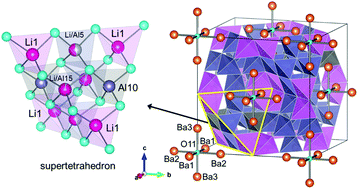Li7Ba3Al3O11: a new supertetrahedral oxide†
Abstract
Colorless, transparent single crystal grains were obtained from a sample prepared by heating compacts fabricated from mixtures of Li2O, BaO, and Al2O3 powders at 1093 K for 6 h under an Ar atmosphere. Single crystal X-ray diffraction analysis showed that these crystals comprised the new compound Li7Ba3Al3O11 having an orthorhombic cell (lattice constants: a = 13.1706(4), b = 13.1743(4), c = 13.1372(4) Å). The crystal structure of this compound is close to the cubic structure of La3Cr9.24N11 (space group Fm![[3 with combining macron]](https://www.rsc.org/images/entities/char_0033_0304.gif) m) and contains eight supertetrahedra formed via the vertex-sharing of ten Li-, Li/Al-, and Al-centered oxygen tetrahedra. These supertetrahedra are arranged in the unit cell on the basis of edge-sharing. The crystal symmetry was reduced from cubic Fm
m) and contains eight supertetrahedra formed via the vertex-sharing of ten Li-, Li/Al-, and Al-centered oxygen tetrahedra. These supertetrahedra are arranged in the unit cell on the basis of edge-sharing. The crystal symmetry was reduced from cubic Fm![[3 with combining macron]](https://www.rsc.org/images/entities/char_0033_0304.gif) m to orthorhombic Pnnn as a result of the partial ordering of Li and Al atoms in the oxygen tetrahedra with various Li/Al site occupancies from 0.0/1.0 to 1.0/0.0. Polycrystalline samples of Li7Ba3Al3O11 were synthesized by heating a mixture of starting materials in the molar ratio corresponding to the stoichiometric composition of Li7Ba3Al3O11 at 1073 K for 6 h under Ar. The electrical conductivity of a polycrystalline sample was determined using the direct current two-terminal method with Li electrodes to be 1.3 × 10−8 S cm−1 at 553 K. The estimated activation energy in the range of 553–673 K was 0.88 eV.
m to orthorhombic Pnnn as a result of the partial ordering of Li and Al atoms in the oxygen tetrahedra with various Li/Al site occupancies from 0.0/1.0 to 1.0/0.0. Polycrystalline samples of Li7Ba3Al3O11 were synthesized by heating a mixture of starting materials in the molar ratio corresponding to the stoichiometric composition of Li7Ba3Al3O11 at 1073 K for 6 h under Ar. The electrical conductivity of a polycrystalline sample was determined using the direct current two-terminal method with Li electrodes to be 1.3 × 10−8 S cm−1 at 553 K. The estimated activation energy in the range of 553–673 K was 0.88 eV.



 Please wait while we load your content...
Please wait while we load your content...